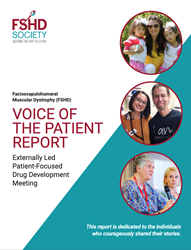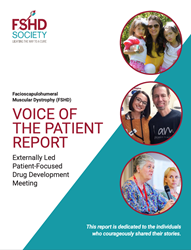
FSH muscular dystrophy Voice of the Patient Report.
This disease is wicked and cruel in many ways, but losing my independence is probably the most frightening and helpless feeling I have ever had.
LEXINGTON, Mass. (PRWEB)
November 12, 2020
The FSHD Society has released its Voice of the Patient Report, a landmark publication based on its June 29, 2020, externally led patient-focused drug development (EL-PFDD) meeting. During the meeting, individuals and families living with facioscapulohumeral muscular dystrophy (FSHD) testified before representatives of the U.S. Food and Drug Administration (FDA) and other stakeholders about how the muscle-wasting disease affects their health, and what they hope future treatments will do to improve their quality of life. According to the FDA, “This input can inform FDA’s decisions and oversight both during drug development and during our review of a marketing application.”
One of the most common types of muscular dystrophy, FSHD affects an estimated 1 in 8,300 people in the general population. Caused by a genetic aberration on chromosome 4, FSHD results in a life-long, progressive loss of muscle strength, with around 20 to 25 percent of affected individuals needing a wheelchair by age 50. Affected individuals have a 50-50 chance of passing the condition on to each offspring. There is currently no treatment to slow the loss of strength and muscle.
For its EL-PFDD meeting, called the “Voice of the Patient Forum,” the FSHD Society produced a live webcast to protect attendees from potential exposure to the COVID-19 virus. Some 400 individuals participated via Zoom, email, and phone. Their input is captured in the Voice of the Patient Report and will provide the FDA and the biopharmaceutical industry with deep insights into how FSHD affects individuals’ health, daily lives, and well-being. The report also documents the ineffectiveness of current interventions and the urgent need for better treatments.
The report puts to rest some misconceptions about FSHD. For example, FSHD is often described as a “mild” muscular dystrophy, but more than 80 percent of respondents reported being “moderately” to “severely” limited in daily activities involving the upper and lower extremities. Medical texts often describe FSHD as mainly affecting the upper body, and yet one-quarter of respondents said that their ability to walk was significantly impaired. Individuals with FSHD are at risk of falling and sustaining serious injuries as a result. One 27-year-old woman said, “I’ve fallen by myself many times, and I think one of the scariest things about falling, is I’m scared that I’m going to hit my head, and I’m scared that someone’s going to find me unconscious. And I’m scared that, one day I’ll fall and I’ll break something, and lose even more mobility.”
Many participants noted that while the disease affects skeletal muscles, it takes a heavy toll on mental health because symptoms worsen over time but in an unpredictable way. “The disease is relentless,” a father of two adult daughters with FSHD said. “It takes away my daughters’ independence, and to a large extent darkens their future.” A 50-year-old man testified, “This disease is wicked and cruel in many ways, but losing my independence is probably the most frightening and helpless feeling I have ever had.”
Short of a cure, the majority of participants indicated that treatments to slow or halt the disease progression was a highly desired outcome. They signaled their preference for slowing or stopping the loss of muscle function (62%), followed by regaining strength and/or muscle function (32%). A common theme in the comments shared during the meeting is that people with FSHD are willing to tolerate a higher degree of uncertainty about the effectiveness of a new drug, given the dire, unmet need they currently experience.
“Having a significant treatment for FSHD would really be life changing,” said a 26-year-old woman. “I would like to see something that would stop progression of the disease. If I were to stop progression right now, I would still be able to walk in 10 years. I would still be able to smile, to get off the couch, to raise my arms, to hold my future baby and countless other things….” The mother of a young girl with FSHD testified, “Our future and hers stay in limbo with so many unknowns – that if we had a therapy that at minimum slowed the progression… we would be able to guide and plan for what her future looks like.”
The FSHD Voice of the Patient report and webcast recording are available on the FSHD Society’s website. Advocacy partners and sponsors included Friends of FSH Research, Fulcrum Therapeutics, Muscular Dystrophy Association, and Optum. The Society dedicated the report “to the individuals who courageously shared their stories.”
About the FSHD Society
The FSHD Society is the world’s largest research-focused patient organization for facioscapulohumeral muscular dystrophy (FSHD), one of the most prevalent forms of muscular dystrophy. The Society has catalyzed major advancements and is accelerating the development of treatments and a cure to end the pain, disability, and suffering endured by one million people worldwide who live with FSHD. The FSHD Society has transformed the landscape for FSHD research and is committed to making sure that no one faces this disease alone. The Society offers a community of support, news, and information through its website at https://www.fshdsociety.org.
Share article on social media or email:

